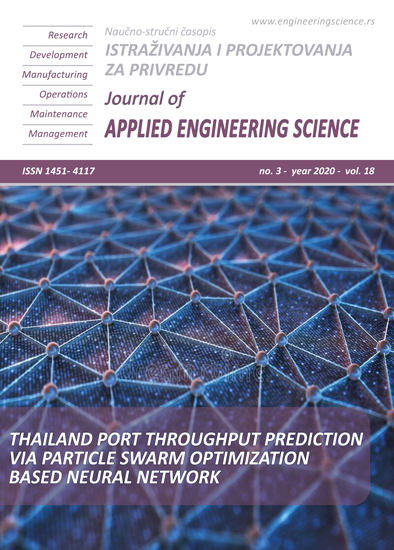INFLUENCE OF THE CALCULATED LENGTH OF ELEMENTS ON THE CRITICAL PARAMETERS OF STABILITY OF FRAME-BAR STRUCTURAL SYSTEMS
Abstract
This article examines the effect of changing the design length of the elements of frame-bar structural systems operating in a constrained bifurcation. For the criterion of the form of buckling of an element of a frame-bar structural system, the sign of the work of end moments and shear forces is taken. Using this criterion, an expression was obtained to assess the effect of changing the calculated length of the frame struts on the critical parameters of the entire system, which allows varying the geometry of the structure to influence its performance.
A two-span frame is considered, in which the central pillar is loaded with a concentrated force Pcr, and the outer pillars are loaded with forces αRcr. The type of bifurcation of the rods (constrained or forced) and the critical parameters of the stability of the system before and after changing the calculated length of its elements are determined.
Changes in the design length of elements that passively lose stability do not have a significant effect on the critical stability parameters of the frame-bar structural system. At the same time, a 30% decrease in the calculated length of the struts in an active bifurcation leads to a decrease in the critical force by 50%.
The presented rather simple algebraic dependencies allow obtaining a qualitative and quantitative assessment of the effect of the calculated length coefficient on the stability of frame-rod structural systems made of wood. It has been established that the conditions for securing elements that passively lose stability do not have a significant effect on the critical parameters of the system.
References
2. Aleksandrov, AV Criteria for identifying the most dangerous elements and their use in problems of structural stability / AV Aleksandrov, AV Matveev // Safety of train traffic: tr. 4th scientific-practical. conf. - M .: MIIT, 2003. - S. III-1 - III-2.
3. Aleksandrov, A. V. About the calculation of rod structures for stability / A. V. Aleksandrov, V. I. Travush, A. V. Matveev // Promyshlennoe i grazhdanskoe stroitel'stvo. - 2002. - No. 3. - P. 16-20.
4. Aleksandrov, A. V. The role of individual elements of the rod system at loss of stability / A. V. Aleksandrov // Bulletin of MIIT. - 2001. - Issue. 5. - P. 46.
5. Dmitrieva, K.O. Issues of stability of rod elements of structural systems made of wood under power and environmental loading / N.V. Klyuev, K.O. Dmitrieva // Construction and reconstruction. - 2016. - No. 4. S. 13-18.
6. Dubrakova, K.O. Issues of stability of statically indeterminate wood systems / K.O. Dubrakova // BST: Bulletin of construction equipment. - 2018. - No. 11. S. 54-55.
7. Klyueva, N.V. Analysis of the stability of timber structures under power loading and variable humidity / N.V. Klyuev, K.O. Dmitrieva // Scientific Bulletin of the Voronezh State University of Architecture and Civil Engineering. Construction and architecture. - 2016. - No. 3. S. 17-24.
8. Klyueva, N.V. Issues of stability of rod elements of structural systems made of wood of various species under power and environmental loading in conditions of high humidity / N.V. Klyuev, K.O. Dmitrieva // Construction and reconstruction. - 2016. - No. 5. S. 60-68.
9. Matveev, A. V. Some issues of creating a specialized software complex for the analysis of bridge structures / A. V. Matveev // MIIT Bulletin. - 2002. - Issue. 7. - P. 76-83
10. Pyatikrestovsky, KP Nonlinear deformations of statically indeterminate wooden structures. Pyatikrestovsky, Kh.S. Khuganov // News of higher educational institutions. Building. - 2013. - No. 11-12. - S. 21-30.
11. . Pyatikrestovsky, K. P. Nonlinear methods of mechanics in the design of modern wooden structures / K. P. Pyatikrestovsky. - M .: MGSU, 2014 .-- 320 p.
12. Pyatikrestovsky, K. P. On programming a nonlinear method for calculating wooden structures / K. P. Pyatikrestovsky, V. I. Travush // Academia. Architecture and construction. - 2015. - No. 2. - P. 115-119.
13. Smorchkov, A.A. Safety of structures made of glued wood at the manufacturing stage / A.A. Smorchkov, D.A. Orlov, S.A. Kereb, K.O. Baranovskaya // Industrial and civil construction. - 2013. - No. 12. S. 74-75.
14. Travush, V.I. Long-term strength and stability of compressed wood rods / V.I. Travush, V.I. Kolchunov, K.O. Dmitrieva // Construction and reconstruction. - 2015. - No. 5. S. 40-46.
15. Travush, V.I. Stability of compressed wood rods with simultaneous manifestation of power and environmental impact / V.I. Travush, V.I. Kolchunov, K.O. Dmitrieva // Building mechanics and calculation of structures. - 2016. - No. 2. S. 50-53.
16. Travush, V.I. Experimental and theoretical study of the strength and stability of compressed wood rods under power and environmental impact / V.I. Travush, V.I. Kolchunov, K.O. Dmitrieva // News of higher educational institutions. textile industry technology. - 2016. - No. 3. S. 280-285.Dubrakova K. O. The buckling of the physically nonlinear frame-rod structural systems/Dubrakova, K.O., Dubrakov, S.V., Altuhov, F.V., Galaeva, D.H.// 2019 IOP Conf.: Mater. Sci. Eng. 698 022007.
17. Yemelyanov S. G. Stability of statically indefinite physically nonlinear timber structural systems)/ Yemelyanov S. G., E. G. Pakhomova, K. O. Dubrakova, S. V. Dubrakov // Journal of Applied Engineering Science. Paper number: 17(2019)3, 622, 404 – 407, doi:10.5937/jaes17-21686.
18. Yemelyanov S. G. Reliability of RC frame-braced systems in dangerous geological conditions / Yemelyanov S. G., E. G. Pakhomova, K. O. Dubrakova // Journal of Applied Engineering Science Paper number: 17(2019)2, 602, 245 – 250, doi:10.5937/jaes17-21685.

